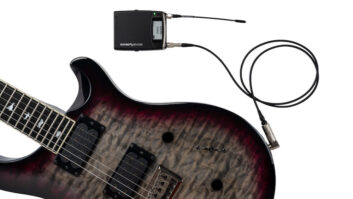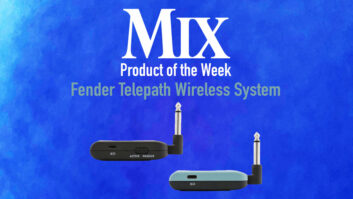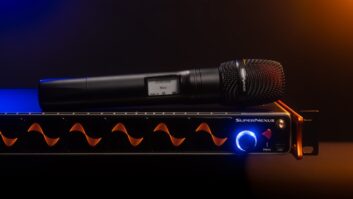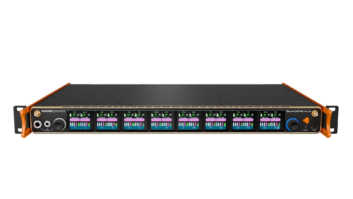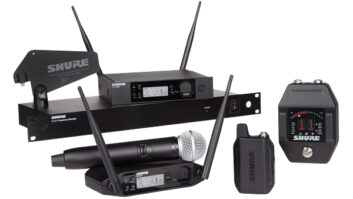
New York, NY (May 23, 2024)—Launched earlier this year at NAMM, the Astral Wireless Guitar System from Sound Devices was designed specifically for guitar and bass.
The system consists of the company’s A20-TX Transmitter with A20-TX Guitar Strap Clip, A20-TX Smart Guitar Cable, and A20-Nexus True-Diversity Wireless Receiver. The system features the company’s proprietary SpectraBand technology for extremely wide tuning range and bandwidth (169 MHz to 1525 MHz), enabling the same transmitters and receivers to be used in any country, globally.
At the heart of the Astral Wireless Guitar System is the patent-pending A20-TX Smart Guitar Cable, which incorporates proprietary circuitry within the ¼-inch instrument plug and allows user-adjustable capacitance and impedance, ensuring that the instrument’s pickups are loaded the same way with the wireless transmitter as they would be if they were plugged into an instrument amplifier.
Cable capacitance can be adjusted from 0 pF to 1500 pF in 25 pF steps, corresponding to cable lengths of 1 to 60 feet in one-foot steps, while impedance may be set to 100k, 1M and 10M ohms; these parameters may be adjusted at the A20-TX Transmitter or remotely from the A20-Nexus receiver.
Using the A20-TX Smart Guitar Cable, the system can handle an input level of 18V peak-to-peak(!), and provides a dynamic range of 140 dB, making it appropriate for use with active “hot” pickups. Output from the ¼-inch instrument connector to the transmitter input is balanced, ensuring low-noise operation.
The Astral Wireless transmitter incorporates Sound Devices’ GainForward technology, which eliminates the need to adjust audio gain at the transmitter. System gain is 0 dB from input to output, thus maintaining the same gain structure as a cable when used with pedalboards or plugged directly into an amplifier.
The A20-TX Transmitter runs up to 12 hours and can be powered using three AA batteries (Alkaline, Lithium or NiMH), or rechargeable Lithium-Ion or LiFePO4 batteries; the unit features a built-in charger via USB-C port.
Transmission is proprietary, 100% digital RF modulation with long range and an audio bandwidth of 10 Hz to 20 kHz (±1 dB). Transmitter power may be set to Low (2 mW), Normal (10 mW), High (20 mW) and Extra High (40 mW). Latency is stated to be 1.9 mS.
Metric Halo Production Bundle v4 – A Mix Product of the Week
The A20-TX Transmitter’s Lemo input accommodates a variety of audio input sources, including analog mic or line, standard 2- or 3-wire lavalier mics, and AES42 or AES3 digital sources. The transmitter can be remotely controlled via Bluetooth using Sound Devices’ A20-Remote app for Android, iOS or iPad. A two-sided guitar strap clip ensures that the transmitter will hold securely to any guitar strap, while a built-in recorder can store audio (32-bit floating-point/48 kHz) to a removable micro-SD card.
A20-Nexus True-Diversity Wireless Receivers are capable of packing 8 channels in a half-rack chassis, expandable to 12 or 16 channels via A20-Nexus 4-Channel Expansions. The receiver’s AutoAssign function automatically scans the RF environment for clear frequencies, assigns them to multiple channels, then automatically pushes those frequencies to transmitters that have been linked to the receiver using NexLink, Sound Devices’ exclusive protocol for remote control. Pairing of A20 receivers and transmitters is typically done once during initial setup, after which pairing is recalled.
A front-panel array of color OLED displays facilitate control and monitoring of all functions, or the A20-Nexus may be remote-controlled using a web-based app running on any computer, smartphone or tablet.
Power may be sourced from PoE+, DC input (with redundancy), AC mains with an optional adapter, or via Sound Devices 8-Series through unit-to-unit connector when docked.
Audio output is via Dante or dual DB25 connectors carrying mic, line or AES output, and the A20-Nexus receiver is capable of converting 16 channels of Dante to mic- or line-level analog audio and/or AES via the DB25s. The unit supports sample rates of 44.1, 48 or 96 kHz.
Additional features of the A20-Nexus True-Diversity Wireless Receiver include dual BNC antenna jacks front and rear, front-panel headphone output, two RJ45 ports for Dante and/or control; LTC/word clock input, dual 4-pin Hirose DC outputs for powering IFB transmitters, camera hops, or other low-power peripherals, and a multi-function USB-A port that can be used for pairing and syncing timecode to A20 transmitters, connecting a USB keyboard for naming channels, etc., or mounting a USB thumb drive for updating firmware and saving or loading settings.
